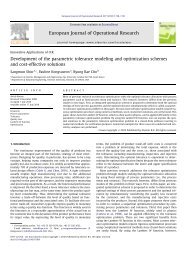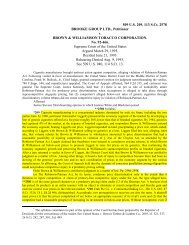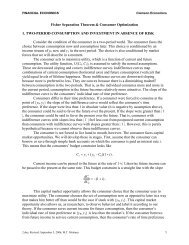A comparative discrete-dislocation/nonlocal crystal-plasticity
A comparative discrete-dislocation/nonlocal crystal-plasticity
A comparative discrete-dislocation/nonlocal crystal-plasticity
You also want an ePaper? Increase the reach of your titles
YUMPU automatically turns print PDFs into web optimized ePapers that Google loves.
typeset2:/sco3/jobs1/ELSEVIER/msa/week.17/Pmsa15088y.001 Wed May 16 07:53:37 2001 Page Wed<br />
D. Columbus, M. Grujicic / Materials Science and Engineering A000 (2001) 000–000 13<br />
Fig. 6. (a) The equivalent plastic strain contour plot; (b) the 22 stress<br />
contour plot and (c) the deformed finite element mesh for the<br />
<strong>nonlocal</strong> <strong>crystal</strong> <strong>plasticity</strong> (Model-I) analysis at the onset of crack<br />
extension (K I/K I0=1.18, arrows indicate position of crack tip).<br />
addition, the stress levels in the corresponding three<br />
regions are comparable for the two types of analyses. A<br />
comparison of the distorted finite element mesh resulting<br />
from the <strong>crystal</strong>-<strong>plasticity</strong> analysis, Fig. 6c, with the<br />
corresponding mesh resulting from the <strong>discrete</strong>-<strong>dislocation</strong><br />
analysis, Fig. 3c, indicates very similar crack profiles<br />
in the two cases. However, the deformation bands<br />
observed in Fig. 3c, can not be readily identified in Fig.<br />
6c.<br />
To show the role of the <strong>nonlocal</strong> <strong>crystal</strong>-<strong>plasticity</strong><br />
phenomenon on mode I crack growth behavior, the<br />
equivalent plastic strain, the normal, 22, stress contour<br />
plot, and the distorted mesh obtained from a <strong>crystal</strong>-<strong>plasticity</strong><br />
analysis based on Model-I parameters, but with the<br />
<strong>nonlocal</strong> parameters (c, a0 and a1) turned off, at the same<br />
level of stress intensity factor as in Fig. 6a–c (KI/KI0= 1.18), are shown in Fig. 7a–c. This analysis is referred<br />
to as a local <strong>crystal</strong>-<strong>plasticity</strong> analysis.<br />
The main differences in the distribution of equivalent<br />
plastic strain in local (Fig. 7a) and <strong>nonlocal</strong> (Fig. 6a)<br />
<strong>crystal</strong>-<strong>plasticity</strong> analyses can be summarized as follows:<br />
1. higher values of equivalent plastic strain are observed<br />
in the local-<strong>plasticity</strong> case and the highest<br />
plastic-strain region is located at the crack tip. In<br />
the <strong>nonlocal</strong> <strong>crystal</strong>-<strong>plasticity</strong> case, the highest plastic-strain<br />
region is slightly removed from the crack<br />
tip;<br />
2. the plastic strain bands, while well formed in both<br />
cases, appear to be narrower in the local-<strong>plasticity</strong><br />
case.<br />
A comparison of the local, Fig. 7b, and <strong>nonlocal</strong>,<br />
Fig. 6b, 22 stress distributions indicates that while the<br />
distributions are quite similar, ca. 8% higher tensile<br />
stress levels are attained in the <strong>nonlocal</strong> <strong>crystal</strong>-<strong>plasticity</strong><br />
case.<br />
A comparison of the local, Fig. 7c, and <strong>nonlocal</strong>,<br />
Fig. 6c, deformed finite element meshes indicates significant<br />
differences in the crack profile especially near<br />
the crack tip. In the local <strong>crystal</strong>-<strong>plasticity</strong> case, the<br />
crack tip is quite blunted and no crack advance is<br />
observed. In sharp contrast, the crack tip is considerably<br />
sharp and crack extension is observed in the case<br />
of <strong>nonlocal</strong> <strong>crystal</strong> <strong>plasticity</strong>.<br />
The equivalent plastic strain, the normalized 22 stress contour plot, and the deformed finite element<br />
mesh at the onset of crack extension (KI/KI0=1.53) for<br />
the Model-II <strong>nonlocal</strong> <strong>crystal</strong>-<strong>plasticity</strong> analysis are<br />
shown in Fig. 8a–c, respectively.<br />
A comparison of the equivalent plastic strain distributions<br />
obtained using Model-II (Fig. 8a) and Model-I<br />
(Fig. 6a) <strong>nonlocal</strong> <strong>crystal</strong>-<strong>plasticity</strong> analyses indicates<br />
that higher plastic strain levels are attained in the<br />
former case. In addition, the highest plastic strain region<br />
in the case of Model-II is located at the crack tip.<br />
These findings are consistent with the fact that in order<br />
to delay the onset of crack extension in the Model-II<br />
UNCORRECTED PROOF<br />
crack tip is associated with the highest tensile stress<br />
values while the region behind the crack tip contains<br />
low-magnitude primarily negative 22 stress values.<br />
These observations are fully consistent with the ones<br />
made during the <strong>discrete</strong>-<strong>dislocation</strong> analysis, Fig. 3b. In
















